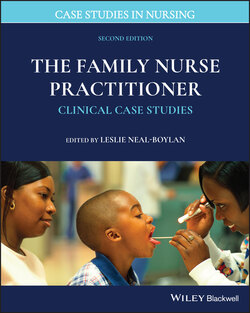Читать книгу The Family Nurse Practitioner - Группа авторов - Страница 52
ОглавлениеCase 6.2 Bleeding in the First Trimester of Pregnancy
By Meredith Scannell, PhD, MSN, MPH, CNM, CEN, SANE‐A
SUBJECTIVE
Tasha is a 44‐year‐old female who presents with a sudden onset of heavy vaginal bleeding. She reports that the bleeding started 2 days ago; it started slowly but progressed to heavy bleeding that required menstrual pads to be changed every 2–3 hours since awaking this morning. Tasha also reports significant cramping and pain in the lower abdomen. She describes having irregular menstrual cycles over the past year due to perimenopausal changes. Her last menstrual cycle was 2 months ago; it was light and lasted only 3–4 days. Tasha reports some occasional nausea over the past few weeks that occurs for short durations in the morning.
Past medical history: History of retinal detachments requiring surgical repair.
Menstrual history: Tasha began her menstrual cycle at the age of 14. Prior to beginning perimenopause, she had 28‐day cycles lasting 5–6 days.
Obstetrical history: G4 T2 P0 A2 L3. Tasha had 2 full‐term pregnancies. The first was a singleton at 38 weeks’ gestation in which the delivery was an uncomplicated normal spontaneous vaginal birth. The second was a twin pregnancy at 37 weeks via uncomplicated Cesarean section. Tasha has also had 2 spontaneous miscarriages.
Family history: Tasha’s mother has a history of tension headaches and transient ischemia attacks. Her father has a history of hypertension and myocardial infarction. Her sister has a history of systemic lupus erythematosus and infertility issues.
Social history: Tasha does not smoke; she drinks 4–5 times each week with 1–2 glasses of wine per setting. She reports occasionally drinking more than 6 drinks in a setting 1–2 times per year when there are celebratory occasions such as weddings. She is married and works as a funeral director. She has 1 teenage daughter who is in her senior year in college and two 19‐year old sons who started college in the fall. She has been married for 20 years to her high school sweetheart. She denies any concerns of domestic violence and reports feeling safe at home.
Sexual history: Tasha reports being in a mutually monogamous relationship with her husband. She engages in sexual activity 1–2 times per week and reports feeling satisfied with the level of sexual activity. She denies any use of condoms; she is not concerned about pregnancy because she is perimenopausal.
Genitourinary: Tasha denies any dysuria, frequency, or incontinence.
Medications: Tasha take no prescribed medication; over‐the‐counter medications include multivitamin QD, Vitamin D 200IU QD, fish oil 1,200 mg QD, ibuprofen 600 mg, as needed for pain.
Allergies: Shellfish (rash), IV contrast (rash), Reglan (difficulty breathing).
OBJECTIVE
General: Tasha appears in some distress and is guarding of her lower abdomen. She is neatly dressed; affect is appropriate for the situation.
Vital signs: BP: 110/52 (L) sitting; P: 90; RR: 18; temperature: 97.8°F; weight: 185 lbs; height: 5 ft 5 inches.
HEENT: Head: Nontender, without masses, hair with normal distribution. Eyes: Clear conjunctivae; PERRLA and intact. Ears: Clear external auditory canals, hearing normal. Mouth/throat: Light pink mucosa, dentition normal.
Skin: Pink, warm, no rashes, and no lesions.
Abdomen: Soft, nondistended, +tenderness lower abdomen above symphysis pubis, no rebound, no Turner sign, no Cullen sign.
Pelvic: Inguinal lymph nodes without swelling or tenderness; no adnexal masses, vaginal mucosa moist light pink. Uterus midline and globular. Cervical os dilated, with blood, no tissue observed. No cervical motion tenderness. Blood noted in the vaginal vault, no tissue noted.
CRITIAL THINKING
1 What is the most likely differential diagnosis in this case?___Spontaneous inevitable abortion___Ectopic pregnancy___Cervicitis
2 Which diagnostic tests are required in this case and why?___CBC with differential___Blood type with Rhesus type and antibody screen___Beta hCG___Progesterone level___Doppler fetal heart tones___Transvaginal ultrasound___Abdominal ultrasound
3 What are the concerns at this point?
4 What is the plan of treatment?
5 What are the plans for follow‐up care?
6 Are there any standardized guidelines that should be used to treat this case? If so, what are they?
